|
|
||||
|
Published by : PROFESSIONAL MEDICAL PUBLICATIONS |
||||
|
ISSN 1681-715X |
||||
|
||||
|
- |
||||
|
ORIGINAL ARTICLE |
||||
|
- |
||||
|
Volume 25 |
October - December 2009 (Part-I) |
Number 5 |
||
|
|
||||
|
|
||||
|
|
||||
|
Published by : PROFESSIONAL MEDICAL PUBLICATIONS |
||||
|
ISSN 1681-715X |
||||
|
||||
|
- |
||||
|
ORIGINAL ARTICLE |
||||
|
- |
||||
|
Volume 25 |
October - December 2009 (Part-I) |
Number 5 |
||
|
|
||||
|
|
||||
Clinical Assessment of glutathione peroxidase and
catalase to the status of maloNdialdehyde in urolithiasis
Roula Hamid Mahmoud1, Mufeed J. Ewadh2, Kadhum J. Al-Hamadani3
ABSTRACT
Objective: To assess the role of lipid peroxidation and antioxidant enzymes in serum of urolithiasis patients.
Methodology: Glutathione peroxidase (GPx), catalase (CAT) and malondialadehyde (MDA) in serum of urolithiasis patients have been measured.
Results: The study has revealed a significant increase in MDA and a significant decrease in GPx and CAT. There have been no significant correlations of serum MDA, GPx and CAT to the size and number of stones with no differences in their levels among patients with one stone, two stones and multiple stones. Anatomically the distributions of urinary stones have been 70.14% renal, 19.30% uretric and 3.15% urinary bladder. There have been no significant difference in serum levels of neither MDA nor CAT among all the anatomical sites of the stone, while GPx has shown a significant difference in serum of patients with renal calyceal, renal pelvic, ureteric and vesical stones. Patients with recurrent episode of urinary stone have been 63.33%. Family histories of urolithiais have been negative in 73.33% of the patients. Neither recurrence of urinary stone nor family history of urolithiasis have shown a significant correlation with serum levels of MDA, GPx and CAT.
Conclusion: The role of lipid peroxidation and antioxidant enzymes is present in the pathogenesis of urinary stone, but their levels donít affect by the size, the number and the anatomical position of stones (apart of GPx which has been affected by the anatomical position of the stone) and the duration, recurrence, and family history of the disease.
KEY WORDS:
Urolithiasis, Malondialdehyde, Glutathione peroxidase and catalase.Pak J Med Sci October - December 2009 (Part-I) Vol. 25 No. 5 738-743
How to cite this article:
Mahmoud RH, Ewadh MJ, Al-Hamadani KJ. Clinical Assessment of glutathione peroxidase and catalase to the status of malondialdehyde in urolithiasis. Pak J Med Sci 2009;25(5):738-743.
1. Roula Hamid Mahmoud,
2. Mufeed J. Ewadh,
3. Kadhum J. Al-Hamadani
1-3: College of Medicine
Babylon University, Iraq.
Correspondence
Dr. Mufeed J. Ewadh,
College of Medicine
Babylon University, Hilla City,
P.O. Box: 473, Iraq.
E-mail: mewadh@yahoo.com,
mufeed55@hotmail.com
* Received for Publication: February 7, 2009
* Accepted: July 26th 2009
INTRODUCTION
Urolithiasis is calculus formation at any level in the urinary collecting system, but most often the calculi arise in the kidney.
1 Stones are composed primarily of a crystalline component.2 The great majority of stones, 70 to 80 percent, are composed of calcium oxalate crystals.3 Stones may become impacted in a renal calyx, at the uretropelvic junction, at the pelvic brim where the uretur arches over the iliac vessels, in the posterior pelvis where the uretur is crossed anteriorly by pelvic vessels , or at the uretrovesical junction.3 To become impacted, calculi usually must have one diameter in excess of 2mm. The smaller diameter is less than 4 mm, spontaneous stone passage is likely.4Lipid peroxidation is a chain reaction providing a continuous supply of free radicals that initiate further peroxidation.
5 Lipid peroxid-ation is initiated by a hydroxyl or other radical that extracts a hydrogen atom from a polyunsaturated lipid, thereby forming a lipid radical. The free radical chain reaction is propagated by reaction with O2, forming the lipid peroxy radical and lipid peroxide. Rearrangements of the single electron result in degradation of the lipid.6 Lipid peroxidation and consequence degradation products such as malondialdehyde are seen in biological fluids.7 Catalase and peroxidases are preventive antioxidants (reduce the rate of chain initiation) that react with ROOH and chelators of metal ions. Catalase (EC 1.11.1.6) is a hemoprotein containing four heme groups,5 which is used to remove H2O2 when it is generated in large quantity. Glutathione peroxidase (EC 1.11.1.9) is a selenium containing enzyme,7 which is one of the most important line of defence against the oxidative damage by hydrogen peroxide or lipid peroxide produced in various cells of the body. It has been suggested that glutathione peroxidasse may be able to break the autocatalytic chain reaction of lipid peroxidation protecting the cell membrane from oxidative damage.8The process of calcium stone formation starts as a precipitation of calcium phosphate either in the loop of Henle or in the distal part of the distal tubule.
9 Although the urine at these levels of the nephron might be critically supersaturated with calcium oxalate in patients with hyperoxaluria and in experimental animals following administration of ethylene glycol, the ion-activity product of calcium oxalate is usually too low to result in calcium oxalate crystal formation.10 Any crystallization that occurs in this part of the nephron most certainly is facilitated by promoters and it has been suggested that lipoprotein membranes from the brush border of proximal tubular cells might serve this purpose11 the brush border membrane might be injured by free radicals formed as the result of toxic effects on the cell.10 This might lead to lipid peroxidation and cell death12 The released membrane fragments that are transported down the nephron thereby can supply a suitable surface for deposition of both calcium oxalate and calcium phosphate.10METHODOLOGY
A total of sixty urolithiasis patients in the age group ranging from 21 to 74 years old, who have had a radio-opaque stone (s) demonstrable on plane film of kidney, ureter and bladder X-ray (KUB) and intravenous utography (IVU). Twenty eight healthy subjects, age and gender have matched from public free from any history of smoking, alcoholism, and coexistence of any medical disease which can also lead to similar changes such as diabetes mellitus and hypertension. All tests have been performed on serum in Biochemistry Department of Collage of Medicine in Babylon University.
Statistics: Studentís t-test was used to determine the significant difference between two groups at p=0.05 level. When multiple means have been compared, significance (p=0.05) has been determined by analysis of variance (ANOVA), followed by Fisherís protected least significant difference test (LSD). While the correlation between two variables have been estimated by Pearsonsís correlation coefficients at 0.05 level
Methods: Serum MDA was determined manually according to Burtis and Ashwood method.
13 Serum GPx was determined manually according to Rotrouck method.14 Serum CAT was determined according to Aebi method manually.15RESULTS
Serum MDA, GPx and CAT in urolithiasis: The mean serum level of MDA has shown an increase in its level in patients with urolithiasis in comparison to that of the control group and it revealed a significant difference with serum MDA in control group. While the mean serum level of glutathione peroxidase and catalase have shown a decrease in their levels and revealed a significant difference with serum GPx and catalase in control group (Table-I).

The correlation of stones number, stones size, and duration of urolithiasis disease to serum levels of MDA, GPx and CAT: The current study has revealed 68.3% of urolithiasis patients have had one stone, two stones in 18.3%, and multiple stones in 13.3%. However, there has been no difference in mean serum levels of MDA and GPx in patients with one stone, two or multiple stones (Table-II)

The mean size of urinary stone in patients with one stone has been 11.65 mm and it revealed no significant correlation with the mean serum levels of MDA, GPx and CAT of patients (r=0.1, -0.05, and -0.01, and p>0.05 for all). In addition, there have been no difference in mean of MDA, GPx, and CAT among patients with one stone, two stones and multiple stones, so the mean size of stones in patient with more than one stone have been taken and the results revealed that serum levels of MDA, GPx and CAT have shown no significant correlation with the size of urinary stone.
The duration of the disease represents the time when the patient are aware of the symptoms of urolithiasis till presentation. The mean duration of urolithiasis has been seven months. It has revealed no correlation between the duration of the disease and serum levels of MDA, GPx and CAT (Table-III)
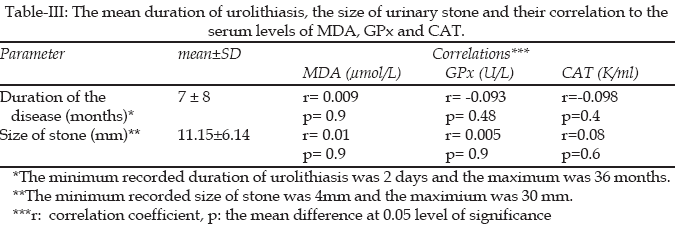
Anatomical distribution of urinary stone and its correlation to serum MDA, GPx and CAT: The patients were divided into five groups according to the anatomical site of the stone in consideration on unilateral or bilateral stones. Renal stones (unilateral or bilateral) have found in 70.17% of patients and ureteric stones in 19.30%. Details of the anatomical distribution of the urinary stones is given in (Fig-1)
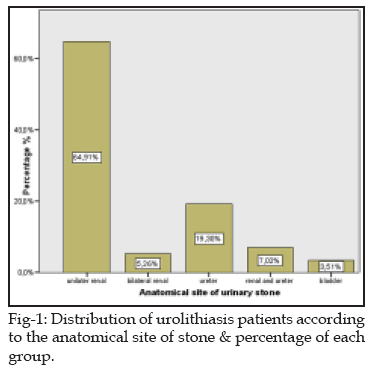
Another anatomical distribution of urinary stone had been identified regardless of the unilateralist or bilateralism to restrict the exact correlated anatomical site to mean serum level of MDA, GPx and CAT, so the patients were grouped into four anatomical positions. These have included the stone in renal calyx, renal pelvis, ureter, and urinary bladder. This anatomical distribution has revealed no significant difference in the mean serum levels of MDA and CAT among urinary stone in renal calyx, renal pelvis, ureter, and urinary bladder (p>0.05). There has been a significant difference in GPx level in serum of uretric stone patients in comparison to its level in serum of renal caliceal and renal pelvic stone patients. Also, the difference in mean of GPx has presented significantly in comparison of vesical stone to renal pelvic and renal calyceal stones. These results are shown in (Fig-2&4).
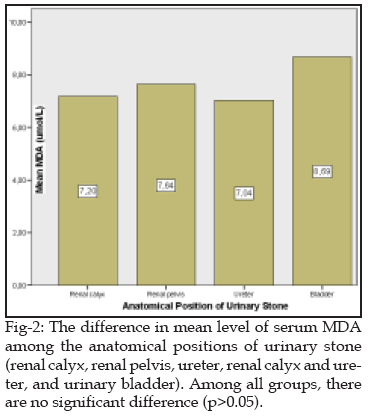
Recurrence and family history of urolithiasis and their correlation to serum level of MDA, GPx and CAT.: The current study has shown 63.33% of urolithiasis patients have had a recurrent stone while, 36.67% have had first episode of stone. The mean levels of MDA, GPx and CAT have shown no significant difference in serum of patients with first episode urolithiasis and recurrent urolithiasis (p>0.05).
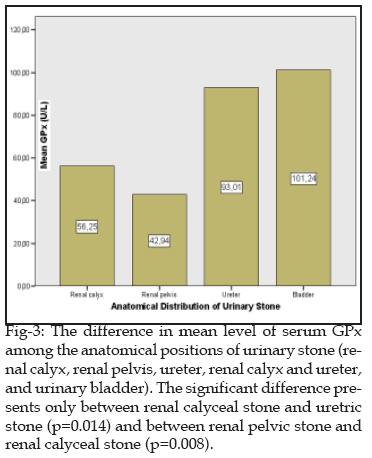
Positive family history of urolithiais has presented in 26.67% of the patients while, 73.33% had negative family history of urolithiasis. Also, the mean serum levels of MDA, GPx and CAT have shown no significant difference concerning negative and positive family history of urolithiasis (p>0.05) (Table-IV).
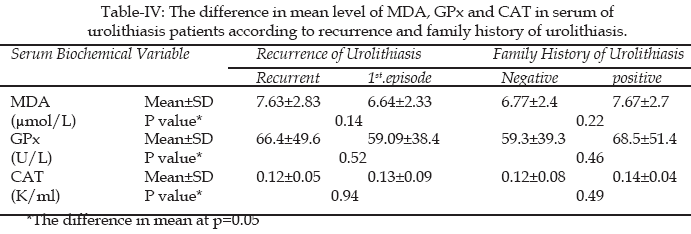
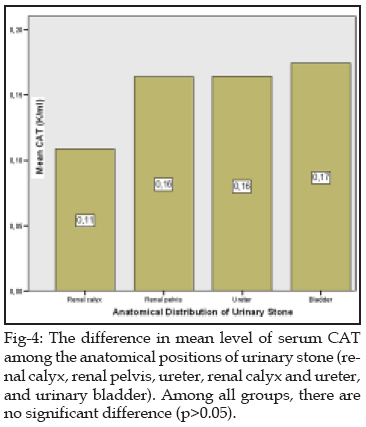
DISCUSSION
The result of significant increase in serum level of MDA is coherent with previous two studies.
16,17 It has been reported that the conditions which enhance peroxidation and depletion of thiol content increase the oxalate binding activity, which in turn promotes nucleation and aggregation property of stone matrix protein fractions. This behavior is also associated with peroxidized mitochondria and nuclei, suggesting that the peroxidation can be a causative factor for the initial stage of stone formation.18 The significant decrease in the serum level of GPx is coherent with other study which has measured the GPx level in the erythrocyte of urolithiasis patients,19 but other study has revealed no significant changes in erythrocyte GPx of urolithiasis patients.20 The current study has revealed a significant decrease in serum CAT. One study has been done on human in India, it has revealed a significant increase in CAT which has been determined in haemolysate of urolithiasis patients,20 while the studies which have been done on experimental rats has shown a significant increase in CAT level in kidney homogenates,21 also the renal epithelial cells (LLC-PK1) has shown a decrease in its cellular contents of CAT after exposure to oxalate.22 Reduction in serum level of GPx and CAT here can be explained due to the consumption of the antioxidant enzyme by increasing the lipid peroxidation.The current study has revealed serum levels of MDA, GPx and CAT were not affected by the duration of urolithiasis disease, stone size and their number. Also, it has revealed that their levels have not affected by recurrence and family history of urolithiasis. Recurrent stone formation in the urinary tract is a common and important problem that must be considered in daily urological practice. With a prevalence of >10% and an expected recurrence rate of 50%, stone disease has an important effect on the healthcare system.
23 It has been reported that there is no significant difference between MDA level of recurrent stone formers & first episode stone formers.17 A positive family history of uro-lithiasis has been found in 26.67% of patients. Although, the percentage differ from other previous study in Baghdad (11.5%), but this suggests that either a genetic or an environmental factor is important in stone formers. Strong family history of stone formation is regarded as a risk factor of recurrent stone formation.24The sequence of the anatomical sites percentage of urinary stone distribution in this is coherent to other previous study.
25 The serum levels of MDA and CAT are not affected by anatomical site of the stone, while serum level of GPx does affect. The lowest level of GPx has been in renal pelvic stone and the highest in uretric vesical and ureteric stones, which it has indicated that the renal pelvic stone has the more consumption of GPx. Although, no difference in MDA level among the anatomical sites of the stone, but the oxidative pool in those patients may contain free radicals other than MDA that have a correlation to these anatomical site. Another possible mechanism that the selenium dependent glutathione peroxidases have five members, one of them is directly synthesized and secreted from proximal tubule cells of kidney.26In summary, the lipid peroxidation and antioxidant enzymes have roles in the pathogenesis of urinary stone, but they are not affected by stones size, stones numbers, recurrence, duration, and family history of the disease. Glutathione peroxidase has not only shown changes in its level, it is also affected by the anatomical stone position and this need further elucidation.
ACKNOWLEDGEMENTS
We express our thanks to Dr. Imad H. Mahmood consultant urologist for his cooperation and advice in collecting the samples from patients who have been diagnosed with urolithiasis. Our gratitude to Mr.Hatim Abdul Lateef Statistician for his scientific explanation of some biostatistics method of analysis.
REFERENCES
1. Kumar V, Cotran RS, Robbins SL. Basic Pathology. 7th ed. SAUNDERS 2002.p:536-537.
2. Tanagho EA and JW McAninch. Smithís General Urology. 17th ed. McGraw-Hill Companies 2008;1-7:246-56.
3. Robert H. Pathology of The Kidney 1992;1572-81.
4. Drach GW. Transurethral Ureteral Stone Manipulation. Urol Clin North Am 1983. 10:709-717.
5. Murray RK, Granner DK, Mayes PA Rodwell VW. Harperís Illustrated Biochemistry. 26th ed. Lange Medical Books/McGraw-Hill 2003;87-91.
6. Marks DB, Marks AD and Smith CM. Basic Medical Biochemistry: clinical approach. 2nded.William and Wilkins 2005;339-454.
7. Vasudevan DM and Sreekumari S. Text book of biochemistry for medical students. 3rded. JAPEE BROTHERS MEDICAL PUBLISHERS (P) LTD 2001;212-15.
8. Binette, JP and Binette MB. Sequence of Protein Extracted from Stones. Scan Micros 1994;8:233-9.
9. Aspline JR, Mandel NS and Coe FL. Evidence for Calcium Phosphate Supersaturation in the Loop of Henle. Am J Physiol 1996;270:604-17.
10. Davison AM, Cameron JS, Grunfeld J, Necker H, Kerr DNS and Ritz E. Oxford Text Book of Nephrology. 3rd ed. Oxford University Press 2005;1199-1210.
11. Khan SR. Calcium Oxalate Crystal Interaction with Renal Epithelium, Mechanism of Crystal Adhesion and its Impact on stone Development. Urol Res 1996;23:71-9.
12. Thamilselvan S and Khan SR. Oxalate and Calcium Crystals are Injurious to Renal Epithelial Cells: Results in vivo and in vitro Studies. J Nephrol 1998;11:66-9.
13. Burtis CA and Ashwood ER. Tietz Text Book of Clinical Chemistry. 3rd ed. Saunders 1999;1034-54.
14. Rotruck JT, Pope AL, Ganther HE Swanson AB, Hafeman DG and Hoekstra WG. Selenium : biochemical role as a componenet of glutathione peroxidase. Science 1973;179:588-90.
15. Aebi H. Methods of Enzymatic Analysis. Academic Press. 1974;674-84.
16. Bet VV, Deshpande KH, Suryakar AN, Ankush RD, Katkam RV. Depleted Nitrite and Enhanced Oxidative Stress in Urolithiasis. Ind J Clin Biochem 2006;21(2):177-180.
17. Buxi J, Sharma k, Mehta RA, Pendse AK, Singh PP. Superoxide Dismutase and Malondialdehyde levels in Urinary Disorders. Ind J Clin Biochem 1994;19(1):47-9.
18. Covindraj A, Selvam R. Increased Calcium Oxalate Crystal Nucleation and Aggregation by Peroxidized Protein of Human Kidney Stone Matrix and Renal Cells. Urol Res 2001;29:194-8.
19. Tungasanga K, Sriboonlue P, Futrakul P, Yachantha C, Tosukhowong P. Renal Tubular Cell Damage and Oxidative Stress in Renal Stone Patients and The Effect of Potassium Citrate Treatment. Urol Res 2004;33(1):56-69.
20. Singh PP, Barjatiya MK. Peroxidative Stress and Antioxidant Status in Relation to Age in Normal and Renal Stone Formers. Ind J Nephrol 2002;12:10-15.
21. Selvam R. Calcium Oxalate Stone Disease: Role of Lipid Peroxidation and Antioxidants. Urol Res 2002;30(1):35-47.
22. Thamilselvan S, Khan SR. Oxalate and Calcium Crystals are Injurious to Renal Epithelial Cells: Results in vivo and in vitro Studies. J Nephrol 1998;11:66-9.
23. Tiselius HG. Epidemiology and Medical Management of Stone Disease. B J U Intern 2003;91:758-67.
24. Litwin MS, CS Sagial. Urological Disease in America. Washington DC US Government Printing Office 2007;283-7.
25. Qadder DS, Yousif SY, Mahdi LS. Prevalence and Aetiology of Urinary Stones in Hospitalised Patients in Baghdad. Eas Mediter Health J 2006;12(6):853-61.
26. Whitin JC, Bhamer S, Tham DM, Cohen HJ. Extracellular Glutathione Peroxidase is secreted by Human Renal Proximal Tubule Cell. Am J Physiol: Renal Physiol 2002;283:20-8.
HOME | SEARCH | CURRENT ISSUE | PAST ISSUES
Professional
Medical Publications
Room No. 522, 5th Floor, Panorama Centre
Building No. 2, P.O. Box 8766, Saddar, Karachi - Pakistan.
Phones : 5688791, 5689285 Fax : 5689860
pjms@pjms.com.pk